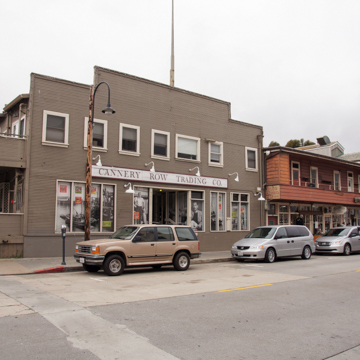You are here
Sea Pride Packing Company Warehouse
This two-story rectangular building is the lone vestige of a typical cannery complex in which the factory was situated on the bay side and an elevated crossing connected it to the storage space across Cannery Row. The associated factory, originally sited just south of Hovden’s Cannery, was built in 1917. This warehouse, dating to circa 1930, replaced an earlier one that had been located on the bay side, just south of the cannery building. The facade is sheathed in wood siding and features a stepped parapet that hides the peak of the front gable roof. The first story is punctuated by storefront windows, while the second story holds six double-hung windows spaced irregularly due to the intrusion of a larger, glassed aperture that was likely the opening for the elevated crossing’s conveyor belt.
The canning process began in the bay: schooners unloaded catches onto a pier, where laborers would cut and gut the fish by hand before laying them out to dry on wooden slats called “flakes.” The dried fish were loaded into metal baskets and conveyed, via a fish ladder, into the cannery, where they were dredged through boiling peanut oil and then drained. They were then deposited into hoppers adjacent to conveyor belts, and workers in an assembly line then packed them into cans by hand. Finished cans were placed on the conveyor belts that delivered them to packers who labeled and box them. The boxes then were conveyed mechanically into the warehouse, where they were stored until they were transported to markets. The apparatuses needed for this assembly necessitated large, open spaces with high ceilings and good ventilation. Long conveyor belts marked the processing room floor, while large pipes and vats marked the perimeter.
The complex was an early Japanese-owned business on the row, founded during World War I by K. Niino, T. Oda, J.N. Oda, and H.C. Suzukawa. By 1926, the business’s interests were sold to the Sea Pride Packing Company, spearheaded by Harry A. Irving. In 1945, the cannery was sold to the New York–based Atlantic Coast Fisheries company. The facility continued operations until the early 1950s but by the following decade the buildings were vacant. In 1980 the cannery burned down but the warehouse survived. It is now a commercial space.
References
Architectural Resources Group. “Final Cannery Row Cultural Resources Survey Report Document.” Prepared for the City of Monterey, California, 2001.
Cannery Row. “The Canneries.” Cannery Row, Monterey, Ca .Accessed July 29, 2017. http://canneryrow.com/.
Writing Credits
If SAH Archipedia has been useful to you, please consider supporting it.
SAH Archipedia tells the story of the United States through its buildings, landscapes, and cities. This freely available resource empowers the public with authoritative knowledge that deepens their understanding and appreciation of the built environment. But the Society of Architectural Historians, which created SAH Archipedia with University of Virginia Press, needs your support to maintain the high-caliber research, writing, photography, cartography, editing, design, and programming that make SAH Archipedia a trusted online resource available to all who value the history of place, heritage tourism, and learning.

